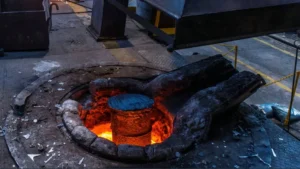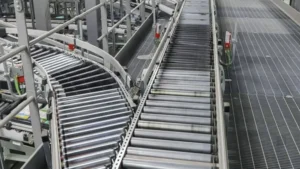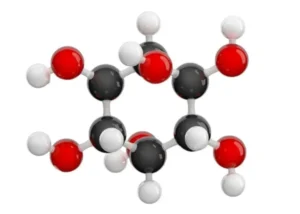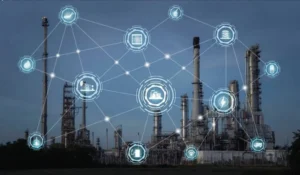This is a detailed introduction to the core components and functions of a Medium Frequency (MF) Induction pugon.
A Medium Frequency Induction Furnace is a type of electric furnace that utilizes the principle of electromagnetic induction. It converts power frequency (50/60Hz) alternating current (AC) into medium frequency (typically 150Hz to 10kHz) AC. This current then generates an alternating magnetic field in the induction coil, which induces eddy currents in the metal charge within the furnace, causing it to heat up and melt.
Its core components mainly include the following four systems, which work in concert and are all indispensable.
1. Medium Frequency Power Supply – The “Heart” of the System

The MF power supply is the most critical component of the furnace. Its function is to convert the three-phase power frequency (50Hz) AC into a single-phasemedium frequency (hal., 1kHz, 2.5kHz, 8kHz) AC to energize the induction coil. Without it, induction heating is impossible.
The workflow of a modern MF power supply (often called an “SCR Power Supply” o “IGBT Power Supply”) is as follows:
- Rectification:
- Component: Rectifier bridge (usually composed of thyristors/SCRs).
- Function: Converts the incoming 50Hz three-phase AC into pulsating direct current (DC).
- Filtering:
- Components: Filter reactor (a large inductor) and capacitors.
- Function: Smooths the pulsating DC into a relatively stable DC, providing a stable “raw material” for the subsequent inverter circuit.
- Inversion:
- Component: Inverter bridge (composed of thyristors/SCRs or IGBT modules). This is the core of the technology.
- Function: “Chops” o “inverts” the stable DC into a single-phase AC of a specific frequency (hal., 1000Hz). This frequency can be adjusted based on melting requirements.
- Sistema ng Kontrol:
- Components: Control circuit board, PLC, atbp.
- Function: This is the “brain” of the power supply. It controls the thyristors’ firing angle, regulates the inverter frequency, and monitors the system (for over-voltage, over-current, water pressure, water temperature), enabling precise power regulation and ensuring the safety of the entire system.
2. Induction Coil – The “Executor” of Energy

The induction coil is the key component for energy conversion. Its function is to convert the medium frequency electrical energy output by the power supply into alternating magnetic field energy.
- Structure:
- It is typically precision-wound from a hollow, rectangular copper tube (T2 copper) with a uniform wall thickness.
- Why hollow? The coil itself generates immense Joule heat ($P = I^2R$) when carrying a large current and must be forcibly cooled with circulating water.
- Working Principle:
- A large medium-frequency current flows through the induction coil.
- According to the law of electromagnetic induction, a powerful and high-frequency alternating magnetic field is generated inside the coil.
- This magnetic field penetrates the metal charge (material) located in the center of the coil.
- The alternating magnetic flux lines induce closed-loop circular currents within the metal charge, known as Eddy Currents.
- The eddy currents, flowing against the metal’s electrical resistance, generate extremely high Joule heat, causing the metal to heat up rapidly and melt.
- Additional Function (Electromagnetic Stirring):
- The interaction between the magnetic field produced by the MF current and the eddy currents creates a stirring force (electromagnetic stirring effect) on the molten metal.
- Advantages: This stirring action makes the temperature and chemical composition of the molten metal more uniform, which facilitates degassing and the removal of impurities, thereby improving the quality of the metal.
3. Furnace Body – The “Vessel” for Melting

The furnace body is the mechanical structure that contains the molten metal, supports the induction coil, and facilitates pouring and casting. It primarily consists of the following parts:
- Refractory Lining / Crucible:
- Function: This is the “crucible” that directly holds the high-temperature molten metal. It is made of refractory materials (such as quartz sand, alumina, or magnesia) that are either rammed (formed) in place inside the furnace or pre-cast.
- Requirements: It must withstand extremely high temperatures (>1600°C), resist chemical erosion and thermal shock from the molten metal, and possess excellent insulating properties to prevent short circuits between the coil and the metal.
- Yoke:
- Structure: Composed of laminated sheets of high-permeability silicon steel, shaped to fit tightly around the outside of the induction coil.
- Functions (Critically Important):
- Constrain the Magnetic Field: Provides a low-reluctance path for the magnetic flux lines generated by the coil, forcing the magnetic field to be highly concentrated within the furnace chamber and reducing magnetic leakage to the outside.
- Improve Efficiency: Reducing magnetic leakage is equivalent to increasing the electro-thermal conversion efficiency, saving power.
- Protect the Furnace Shell: Prevents stray magnetic flux from heating the furnace shell (especially in steel-shell furnaces), thus avoiding overheating, deformation, and ensuring safety.
- Furnace Shell:
- Function: The outer framework of the furnace, used to secure the induction coil and yoke, and to support the entire weight of the furnace body.
- Mga Uri:
- Aluminum-Shell Furnace: Relatively simple structure, lower cost, and experiences more magnetic leakage.
- Steel-Shell Furnace: Robust structure, well-shielded by the yokes, higher efficiency, and longer service life. This is the mainstream choice for modern medium and large-sized MF furnaces.
- Tilting Mechanism:
- Function: Used to tilt the entire furnace body after melting is complete, allowing the molten metal to be poured into a ladle or mold.
- Form: Typically driven by a hydraulic station and hydraulic cylinders (or a reduction gearbox) to achieve smooth and controllable tilting.
4. Paglamig System – The “Safety Guarantee” for Operation
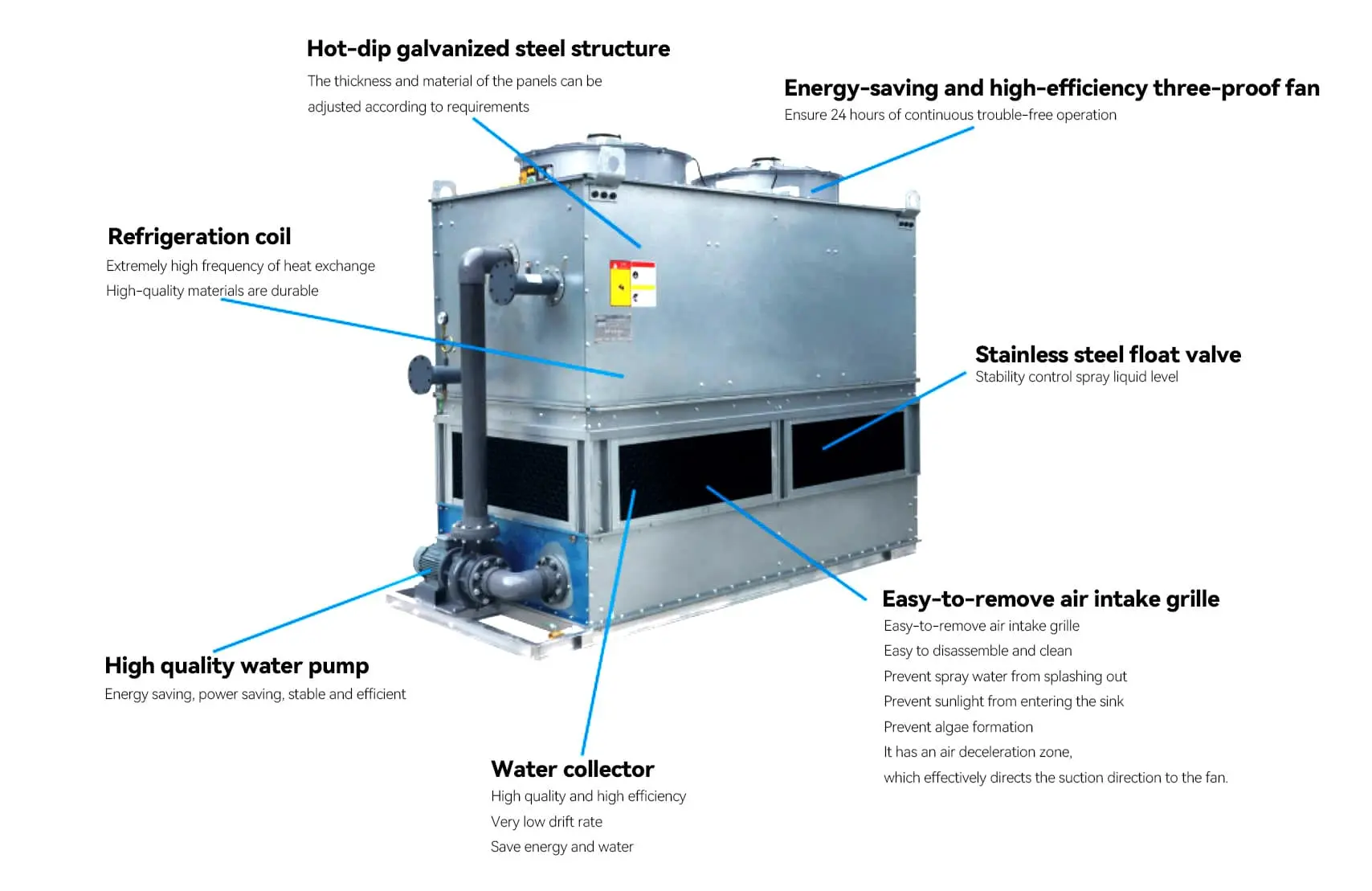
The MF furnace is a high-energy conversion device that generates a massive amount of heat. The cooling system is the lifeline that ensures the safe and continuous operation of the equipment. If the cooling fails, the equipment will be destroyed immediately.
- Components to be Cooled:
- MF Power Supply: Power devices inside, such as thyristors (SCRs) and IGBTs, generate extreme heat during operation.
- Induction Coil: Generates heat from its own current (I²R loss) and also absorbs radiant heat from the high-temperature lining.
- Cables: The water-cooled cables that connect the power supply to the furnace.
- System Composition:
- Water Pump: Provides the force for circulation.
- Cooling Tower / Heat Exchanger: The core heat dissipation component. It releases the heat from the water into the atmosphere.
- Water Tank: For water storage and buffering.
- Pipes, Valves, and Sensors: Form the circulation loop and provide real-time monitoring of water temperature, pressure, and flow rate.
- Key Requirement (Closed-Loop Circulation):
- Because the water-cooled components inside the induction coil and power cabinet are at a high electrical potential, pure or deionized water (inner loop) must be used. This prevents scale buildup (which can block pipes) and high-voltage electrical leakage.
- This pure water is typically cooled via a plate heat exchanger, which is in turn cooled by external industrial circulating water (outer loop, often using a cooling tower). This is known as a “closed-loop cooling system.”
Summary
The four core components of a medium frequency furnace each have a distinct role:
- The Power Supply creates the “medium frequency electrical energy.”
- The Induction Coil converts “electrical energy” sa “magnetic field energy,” which then induces “eddy current thermal energy.”
- The Furnace Body provides the “melting vessel” at “structural support.”
- The Paglamig System removes all waste heat generated by the components, ensuring the “safe and stable operation” ng buong sistema.


